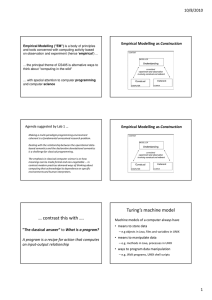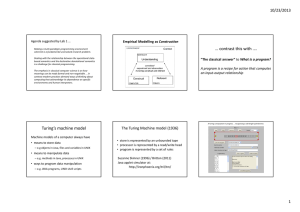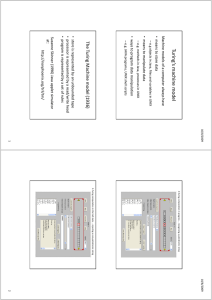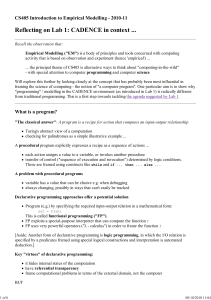10/6/2011 Empirical Modelling as Construction
advertisement
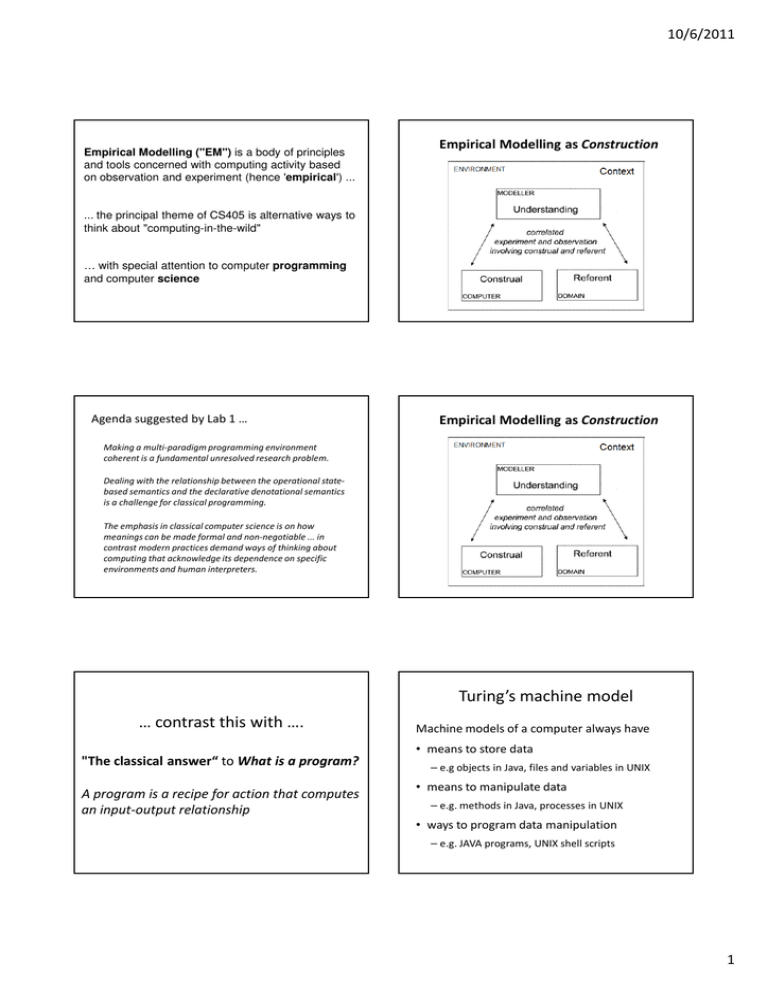
10/6/2011
Empirical Modelling ("EM") is a body of principles
and tools concerned with computing activity based
on observation and experiment (hence 'empirical') ...
Empirical Modelling as Construction
... the principal theme of CS405 is alternative ways to
think about "computing-in-the-wild"
… with special attention to computer programming
and computer science
Agenda suggested by Lab 1 …
Empirical Modelling as Construction
Making a multi-paradigm programming environment
coherent is a fundamental unresolved research problem.
Dealing with the relationship between the operational statebased semantics and the declarative denotational semantics
is a challenge for classical programming.
The emphasis in classical computer science is on how
meanings can be made formal and non-negotiable ... in
contrast modern practices demand ways of thinking about
computing that acknowledge its dependence on specific
environments and human interpreters.
Turing’s machine model
… contrast this with ….
Machine models of a computer always have
• means to store data
"The classical answer“ to What is a program?
A program is a recipe for action that computes
an input-output relationship
– e.g objects in Java, files and variables in UNIX
• means to manipulate data
– e.g. methods in Java, processes in UNIX
• ways to program data manipulation
– e.g. JAVA programs, UNIX shell scripts
1
10/6/2011
A Turing computation in progress … recognising a odd length palindromes
The Turing Machine model (1936)
• store is represented by an unbounded tape
• processor is represented by a read/write head
• program is represented by a set of rules
Suzanne Skinner (1996) / Britton (2011)
Java applet simulator at:
http://ironphoenix.org/tril/tm/
A Turing computation in the halt state … rejecting a non-palindromic string
The Church-Turing thesis
There is no computational model that is in principle
more powerful than the Turing machine …
… all algorithmic data processing is equivalent to
Turing computation
… by this criterion, very simple notations can define
“a full programming language”
Procedural programme to find primes
A procedural program explicitly expresses a recipe
as a sequence of actions ...
A problem with procedural programs …
Procedural variable
- has a value that can be elusive e.g. when debugging
- always changing, possibly in ways that are hard to track
func factors {
para n;
auto r, result;
result = [];
for (r=1; r<=n/2; r++)
if (n % r == 0) result = result // [r];
return result;
}
func isprime {
para n;
return ((factors[n])# == 1);
}
2
10/6/2011
Functional programming (FP)
Program (e.g.) by specifying the required inputoutput relation in a mathematical form:
out = f(in)
This is called functional programming ("FP").
FP exploits a special-purpose interpreter that can
compute the function f
FP uses very powerful operators ("λ - calculus") in order
to frame the function f
A “functional” program to compute prime numbers:
factors n = [r | r<-[1..n div 2]; n mod r = 0]
isprime q = (# factors q) = 1
functional ≡ based on specifying functions
The functions in this context are
factors() and isprime()
The programming language is Miranda
Procedural version of isprime
factors n = [r | r<-[1..n div 2]; n mod r = 0]
func factors {
para n;
auto r, result;
result = [];
for (r=1; r<=n/2; r++)
if (n % r == 0) result = result // [r];
return result;
}
func isprime {
para n;
return ((factors[n])# == 1);
}
isprime q = (# factors q) = 1
Key virtues of declarative programming …
it hides internal states of the computation
have referential transparency
frame computational problems in terms of the external
domain, not the computer
BUT issues for declarative programming …
Legacy of the TM concept of computation:
a highly abstract conception of programming
Makes interaction tricky
Not well-suited to “emerging computing”
‘lazy evaluation’ / dataflow as potential solutions
- diverse and rich contexts for computer use
- non-standard devices, modes of interaction
- reactive systems
- real-time, distributed computing, concurrency
Supporting rich input-output challenging cf. oxo.m
- new challenges for software development …
3
10/6/2011
Legacy of the TM concept of computation:
a highly abstract conception of programming
Not well-suited to “emerging computing”
- new challenges for software development …
- computer + devices + human
- team work, user participation in design
- computer as instrument
Techniques to help address these goals …
object-orientation
agent-based analysis and conception of systems
design patterns
service-oriented architecture
spreadsheet principles
Need software that is comprehensible and
manipulable even by the non-specialist / even
whilst its being constructed
Prototype-based object-oriented code:
this sgobjects puddle
primitive = cube
width = 3.3
height = 3.3
depth = 0.1
visible = true
CADENCE as reflecting many programming paradigms ….
position = (new x=0.0 y=0.0 z=-3.0
z is { @stargate position z }
)
orientation = (new x=0.0 y=2.5 z=0.0
y is { @stargate orientation y }
)
;
Data-flow
#How fast the hole appears
holespeed = 0.8
#The hole animation definition
hole = 1.0
hole := {
if (.ready) {
if (..active) -1.0 else {
..hole - (..holespeed * (@root itime))
}
} else 1.0
}
active = false
active is { .hole < -0.9999 }
A "real-time" ingredient:
match = false
ready = false
locked = false
rotspeed = -0.3
rotation = 0.0
rotation := {
if (.dial and (.match not or (.locked))
and (.ready not)) {
..rotation + (..rotspeed * (@root itime))
} else {
..rotation
}
}
4
10/6/2011
Going beyond classical programming ….
Spreadsheet-style dependencies
position = (new x=0.0 y=0.0 z=-3.0
z is { @stargate position z }
)
orientation = (new x=0.0 y=2.5 z=0.0
y is { @stargate orientation y }
)
Characteristics of tools to be introduced in the module ...
they are concerned with modelling in which we
• observe meaningful things
• adopt a constructivist stance
• exploit an empirical approach
that we wish to reconcile / can be reconciled with the
more abstract, rationalist, theoretical framework that
characterises classical computer science
Reconceptualise by introducing the human dimension ... key
shift in emphasis towards questions such as:
? what is the experience of the people engaging with Turing
computation, procedural programs, functional programs etc.
Consider people's experience ('programmers', 'users', 'modellers'
or 'analysts' etc.) with reference to
* What are the significant things that they observe?
* How are they able to interact and manipulate?
* What is the context for their interaction and interpretation?
when they are engaged in some variety of programming / modelbuilding activity.
The CADENCE environment and the DOSTE engine
5
